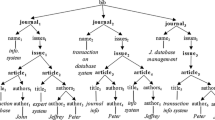Abstract
In XML retrieval, there is often more than one element in the same document that could represent the same focused result. So, a key challenge for XML retrieval systems is to return the set of elements that best satisfies the information need of the end-user in terms of both content and structure. At INEX, there have been numerous proposals for how to incorporate structural constraints and hints into ranking. These proposals either boost the score of or filter out elements that have desirable structural properties. An alternative approach that has not been explored is to rank elements by improving their structural relevance. Structural relevance is the expected relevance of a list of elements, based on a graphical model of how users browse elements within documents. In our approach, we use summary graphs to describe the process of a user browsing from one part of a document to another.
In this paper, we develop an algorithm to structurally score retrieval scenarios using structural relevance. The XML retrieval system identifies the candidate scenarios. We apply structural relevance with a given summary model to identify the most structurally relevant scenario. This results in improved system performance. Our approach provides a consistent way to apply different user models to ranking. We also explore the use of score boosting using these models.
Preview
Unable to display preview. Download preview PDF.
Similar content being viewed by others
References
Apache Lucene Java (2008), http://lucene.apache.org
Ali, M., Consens, M.P., Lalmas, M.: Structural Relevance in XML Retrieval Evaluation. In: SIGIR 2007 Workshop on Focused Retrieval, Amsterdam, The Netherlands, 2007, July 27 (2007)
Ali, M.S., Consens, M., Khatchadourian, S., Rizzolo, F.: DescribeX: Interacting with AxPRE Summary Descriptions. In: ICDE 2008 (accepted, 2008)
Clarke, C.: Controlling overlap in content-oriented XML retrieval. In: SIGIR 2005: Proc. of the 28th Ann. Intl. ACM SIGIR Conf. on Res. and Dev. in IR, pp. 314–321. ACM Press, New York (2005)
Cooper, W.S.: Expected search length: A single measure of retrieval effectiveness based on weak ordering action of retrieval systems. J of the Amer. Soc. for Info. Scie. 19, 30–41 (1968)
Guo, L., Shao, F., Botev, C., Shanmugasundaram, J.: XRANK: Ranked keyword search over xml documents. In: ACM SIGMOD. ACM Press, New York (2003)
Pehcevski, J., Thom, J.A.: HiXEval: Highlighting XML retrieval evaluation. In: Fuhr, N., Lalmas, M., Malik, S., Kazai, G. (eds.) INEX 2005. LNCS, vol. 3977. Springer, Heidelberg (2006)
Polyzotis, N., Garofalakis, M.: Statistical synopses for graph-structured xml databases. In: SIGMOD 2002: Proceedings of the 2002 ACM SIGMOD international conference on Management of data, pp. 358–369. ACM Press, New York (2002)
Trotman, A., Geva, S.: Passage retrieval and other xml-retrieval tasks. In: Proc. SIGIR 2006 Workshop on XML Element Retrieval Methodology, pp. 43–50 (2006)
Trotman, A., Lalmas, M.: Why structural hints in queries do not help xml-retrieval. In: SIGIR 2006: Proceedings of the 29th annual international ACM SIGIR conference on Research and development in information retrieval, pp. 711–712. ACM Press, New York (2006)
Trotman, A., Sigurbjornsson, B.: Narrowed extended XPath I (NEXI). In: Proc. INEX Workshop, pp. 16–39 (2004)
Author information
Authors and Affiliations
Editor information
Rights and permissions
Copyright information
© 2008 Springer-Verlag Berlin Heidelberg
About this paper
Cite this paper
Ali, M.S., Consens, M.P., Khatchadourian, S. (2008). XML Retrieval by Improving Structural Relevance Measures Obtained from Summary Models. In: Fuhr, N., Kamps, J., Lalmas, M., Trotman, A. (eds) Focused Access to XML Documents. INEX 2007. Lecture Notes in Computer Science, vol 4862. Springer, Berlin, Heidelberg. https://doi.org/10.1007/978-3-540-85902-4_3
Download citation
DOI: https://doi.org/10.1007/978-3-540-85902-4_3
Publisher Name: Springer, Berlin, Heidelberg
Print ISBN: 978-3-540-85901-7
Online ISBN: 978-3-540-85902-4
eBook Packages: Computer ScienceComputer Science (R0)




